You are here: The Seven Deadly Sins of Trussed Rafter Construction - Part 2
Please note that this paper is a continuation of The Seven Deadly Sins of Trussed Rafter Construction - Part 1
Sin No 5 Poor site handling and storage
The precise design and careful manufacture of trussed rafters is often undermined by poor site practice. Furthermore, poorly planned unloading and storage can be dangerous and the author is aware of at least one death resulting from bundled trussed rafters falling onto a site operative. Trusses are bundled together in the factory to enable them to be lifted as one unit. One tip for builders to be aware of if they are not already is that manufacturing tolerances on trusses mean that if two trusses were placed adjacent to each other but one to the opposite hand of its manufacture a dip in the roof could well result due to the variation in profile. Manufacturers generally as a habit run a mark down the rafters on one side to show which side of the rafters should always be orientated towards a particular eaves to avoid this problem.
On large well organised sites, a storage facility is put in place into which trusses can be unloaded and stored in an upright position, and then picked off as and when required. On a well organised site, a small crane is often hired to enable the bundled trusses to be lifted directly from the lorry onto the wall plates of the building.
However in many other instances trusses are simply laid flat upon the floor. Such a practice is satisfactory provided that the trusses have a firm and level support of the ground. However this again would involve some preparation.
A frequent practice on small building sites is for trusses to be manhandled from the ground up over the first floor scaffolding and onto the roof. It is inevitable trusses can sometimes bend under their own self weight over the scaffolding handrails.
Trusses are very susceptible to damage when bending out of plane typically the plate connectors can pull out as the joint acts as a hinge. Whilst there is no doubt that this happens and that the plate is pressed back in, (perhaps with a lump hammer), the joint can never have the same strength again if this practice is used. A similar problem can occur when trusses are stored on their sides on uneven ground the cumulative weight of all the trusses can bend the lower trusses out of shape. Notes for Surveyors, it is very difficult to tell whether any plates have been forced back in or indeed whether trusses have suffered from mishandling during construction.
Notes for Building Inspectors, keep an eye out for poor storage procedures and insist that trusses are checked when they appear to have been victim from such situations.
Notes for specifiers, specifications for trussed rafters should require the builder to pre determine the methods by which trusses will be stored on site or if they are to be hoisted directly onto their bearing points. Notes for builders, plan ahead and decide whether to construct proper storage facilities or whether to hire a crane and lift the trusses directly onto the wall plates (recommended).
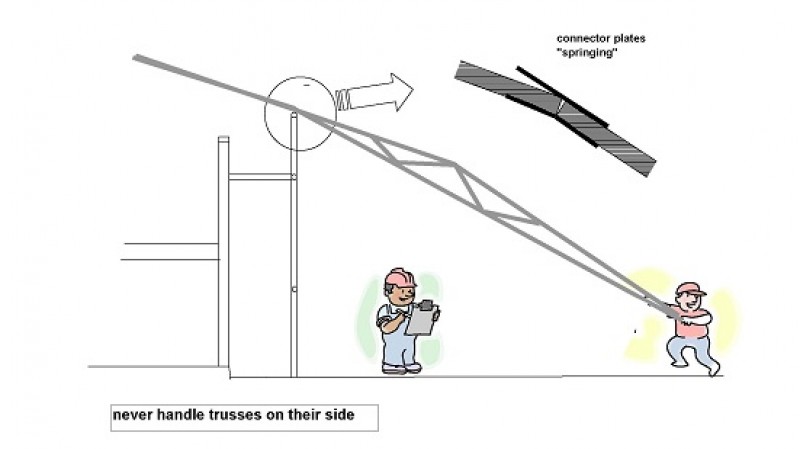
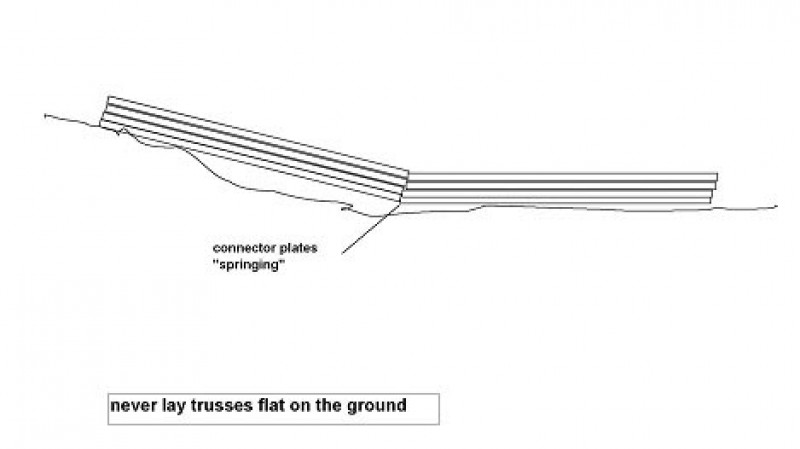
Sin No 6 Poor manufacture and poor construction
All trussed rafter manufacturers subscribe to a quality assurance scheme. However this in itself does not guarantee the trusses are free from fault. The design of truss rafters will normally include a plate positioning tolerance of 5mm. A building inspector or some manager with plenty of time of their hands can insist on having the plate setting out details (always available) and meticulously check each plate to ensure it is within its 5mm positioning tolerance. A simple alternative on a symmetric truss is to just check the setting out of trusses of plates on each side of the truss and if their position deviates by more than 10mm clearly one of them is miss-positioned.
Occasionally trusses are manufactured with gaps over and above the British Standard tolerance between abutting timbers. Clearly such gaps must be within reason, however gaps exceeding the British Standard tolerance need not be considered a particular problem as the truss rafter code requires connectors to transmit all loads between members, so no direct transfer of load by abutting is assumed or required.
Very few buildings would have wall plates that are totally and truly parallel to each other and even fewer where the distance over wall plates is exactly as assumed in the design. A prudent builder will therefore measure the distance over the wall plates at the time when the final order for trussed rafters is placed. It is important that such measurements are taken in several locations in order to determine the widest distance. The British Standard allows the underside of the rafter and the ceiling joists to be up to 50mm away from the wall plate. It is therefore sensible to add 10mm or so onto the over wall plate dimension in order to ensure trusses sit comfortably on the plates.
A complicated roof may have a special wide web to facilitate hanging a special metal bracket for an incoming load from say a girder or a purlin. In such circumstances careful planning of the unloading and hoisting to roof level of the trusses needs to be carried out. It is essential that the side on which the wide web is located is identified early on to ensure the trusses are loaded onto the roof in the right orientation.
The author has seen many instances where valleys are constructed on trussed rafters with no internal support to the valley ridge or the valley jack rafters. This has two detrimental effects on the lying trussed rafters. Firstly the weight of the valley is concentrated on a small number of trusses and secondly the rafter of the underlying trusses in un-braced over a considerable distant. The best solution for forming valleys is always to use factory made valley frames but failing that any site made infill should always include a tie between the feet of the jack rafters nailed to each underlying truss.
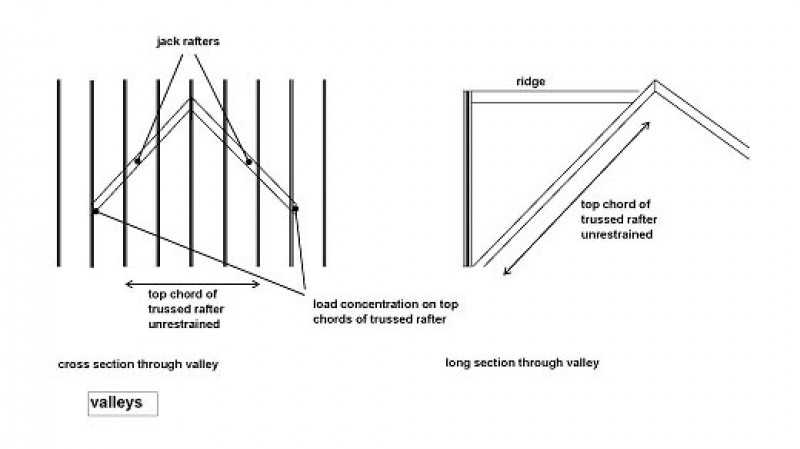
Notes for surveyors and Building Control officers, check that major incoming loads to trussed rafter girders have a suitable hanger fixed to a suitable web. Check that valleys are constructed in a way to distribute the load on the underlying trussed rafters and that the underlying trussed rafters have some fixings to their top chord.
Notes for specifiers. When writing specifications for trussed rafters, require trusses to be ordered with a 10mm tolerance at the heel.
Notes for builders, plan unloading and erecting procedures carefully particularly where asymmetric girders are used properly construct valleys to ensure loads are distributed evenly on the underlying trusses and that there is restraint to the top chords of the trusses.
Sin No 7 Poor specification
Trussed rafter technology and more importantly the power of the software to design and draw trussed rafter roofs have increased significantly over the last two or three decades. Specifiers often want particular eaves details to align with window heads etc. A variety of eaves details are available and should be thoughtfully specified.
Often designers and specifiers complain that they cannot finalise the eaves detail until they know the top chord size of the trussed rafter. Top chord sizes for most span / pitch combinations are in fact no decided by design but by the use of tables of tested spans. An extract of tested span tables is included in this paper.
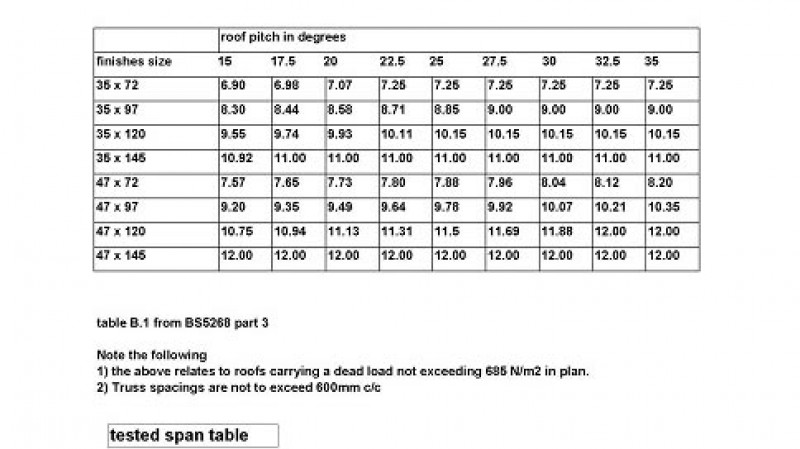
Trussed rafter manufacturers can provide a cantilever truss where desired and can also provide a stub if preferred. Where it is decided to have a room in the roof attic trusses are available, however the room width is limited and is slightly more than would be available from normal joists. However attic type trusses are only suitable where a majority of the roof allows attic trusses to run from wall plate to wall plate without interruption. Where the stairs run at right angles to the line of the trusses, and stroke or there are dormers not always opposite each other, a trussed rafter attic roof may either be unfeasible or a very expensive option. Attic trusses can have much wider attic rooms if an internal wall is available near the centre
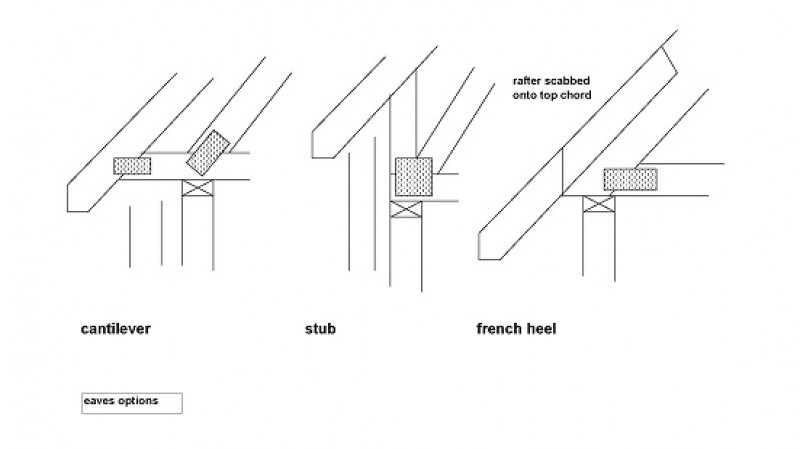
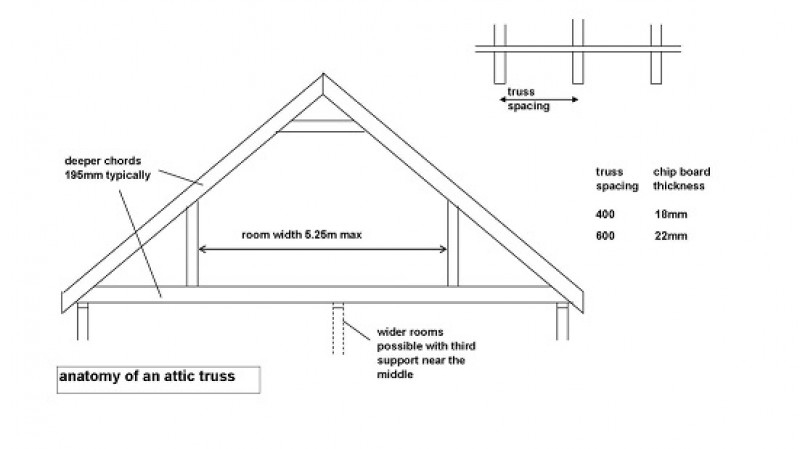
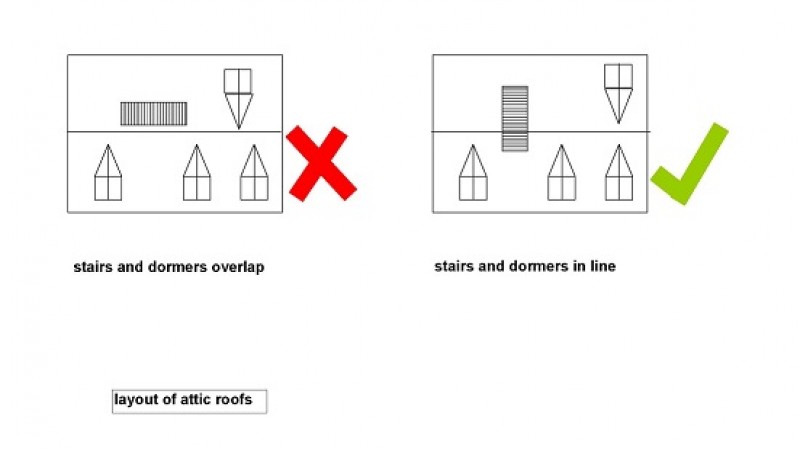
Raised Tie
Very often the preferred eaves detail will involve the ceiling being placed above the wall plate level, known as a raised tie truss. The strain energy in the rafter results in outward movement at the eaves. The trussed rafter industry decided a long time ago that such movement must be limited and generally works on a figure of 6mm at each eaves. This restriction spread is likely to limit the size of the extended leg and dimensions in excess of 1 metre are very difficult to achieve unless there is a middle support. Very often to enable a feasible design to be executed the trussed rafter designer will specify a timber supplement to the rafter referred to as a scab. In extreme cases there may be a scab either side. A trussed rafter manufacturer will provide details of the scabs and details of how they should be nailed. Care needs to be taken in specifying the board thickness. Left to their own devises, and in the interests of economy, attic trusses will normally be designed to be spaced at 600mm centre to centre. Such a spacing will require a thicker than normal board finishing.
For the above reasons raised tie type roofs are limited in what can be achieved with trussed rafters where there is say a hip end or a big intervention to the line of trussed rafters by say a large roof light.

Notes for surveyors, always be on the look out for poorly executed loft conversions where the original roof was standard trussed rafters.
Notes for Building Control officers, always be wary of designs (not supported by a trussed rafter manufacturer’s calculations and details) where excessive raised tie distances or excessive room widths are specified.
Notes for specifiers and builders, always be aware of the limitations of attic trusses and the limitations of raised tie trusses. Where very large room widths are required or a very complicated roof plan results it may well be cheaper to have internal load bearing walls and / or major purlins (glulam or steel.)
SUMMARY
Trussed rafters provide a very economic form of roof structure and can generally be built very quickly.
Discipline needs to be exercised in the specification of trussed rafters and particularly in their erection.
Be always wary of trussed rafter raised tie roofs where the limitations of what can be achieved may make a design unfeasible using factory made trusses.
Building Control inspectors and surveyors always need to be on the look out for unauthorised alterations to trussed rafter roofs.
Loft conversions are a particular menace of which the author has probably looked at some 10 – 15 in the last 10 years.
Very often the advice with a trussed rafter roof which has been altered to form an attic roof is to restore the roof to its original configuration or be prepared to start all over again with the loft conversion.
Loft conversions can typically cost between £15,000 and £25,000 for a small to medium sized house.
Building Inspectors always need to be vigilant for poor storage and poor erection practices.
Laying trusses flat on uneven ground is unfortunately a common practice that the author has witnessed many times.
Despite all the above, trussed rafters are still the structural solution of choice for residential properties and for an increasing number of commercial properties.
Their use allows elegant economic solutions to be formed.
Brian Margetson BSc CEng FIStructE FGS
Former Chairman Of CSB 32/3 British Standards Committee “trussed rafter roofs"
56 Charlcombe Rise, Bristol, BS20 8ND
01275 847074
brian@eccoengineers.co.uk